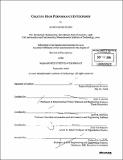Creating high performance enterprises
Author(s)
Stanke, Alexis K. (Alexis Kristen), 1977-
DownloadFull printable version (21.91Mb)
Other Contributors
Massachusetts Institute of Technology. Engineering Systems Division.
Advisor
John S. Carroll.
Terms of use
Metadata
Show full item recordAbstract
How do enterprises successfully conceive, design, deliver, and operate large-scale, engineered systems? These large-scale projects often involve high complexity, significant technical challenges, a large number of diverse stakeholders, distributed execution, and aggressive goals. In this context, simultaneously meeting technical performance, cost, and schedule goals effectively and efficiently is a serious challenge. In fact, it is rarely accomplished. The nature of an enterprise contributes to this challenge. Enterprises are interorganizational networks with distributed leadership and stakeholders with both common and diverse interests. They are unique from traditional levels of analysis in organizational studies, and in general their behavior is not well understood. They are a prevalent form of organizing work in these large engineering projects, where one organization simply does not have the capability or willingness to take on the entire project by themselves. This work explores the factors that distinguish high performance enterprises from those that are less successful in these large-scale projects. The setting for this research is programs in the aerospace industry. (cont.) A comparative case study method was used to study nineteen programs spanning the U.S. (mainly defense) aerospace industry in order to develop grounded theory regarding contemporary program execution strategies and distinguishing attributes. Drawing on prior research with high performance teams, several characteristics were explored and refined, eventually resulting in identification of ten best practices. The contribution of this work is codification of these best practices into a coherent framework of complementary elements relating to particular outcomes. The framework articulates three drivers of individual and systemic behaviors: a system of distributed leadership, informal and formal structures. The framework addresses the role each of these plays in enterprise performance. The synergistic combination of the elements enables enterprises to execute planned activities, leverage emergent opportunities, and deal with unforeseen circumstances. For enterprises involved in large-scale engineering projects, these capabilities are a necessity for success. In addition to an academic theory, this framework can be considered an architectural design for high performance enterprises. Putting this enterprise architecture into practice has important implications for both corporate and program management.
Description
Thesis (Ph. D.)--Massachusetts Institute of Technology, Engineering Systems Division, 2006. Includes bibliographical references (p. 131-140).
Date issued
2006Department
Massachusetts Institute of Technology. Engineering Systems DivisionPublisher
Massachusetts Institute of Technology
Keywords
Engineering Systems Division.